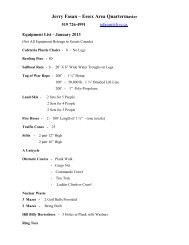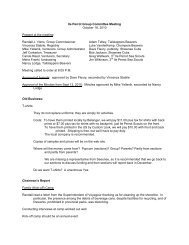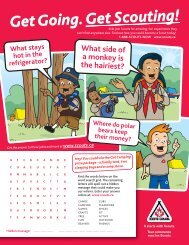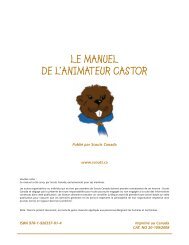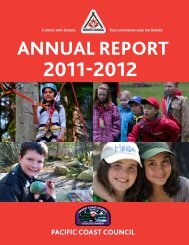Beaver Leader's Handbook - Scouts Canada
Beaver Leader's Handbook - Scouts Canada
Beaver Leader's Handbook - Scouts Canada
You also want an ePaper? Increase the reach of your titles
YUMPU automatically turns print PDFs into web optimized ePapers that Google loves.
4 Understanding that they are trying to achieve and supporting their efforts.<br />
4 Listening to them, their doubts and other feelings.<br />
4 Helping them develop decision-making skills appropriate to their age level.<br />
4 Dealing with them fairly and consistently.<br />
4 Helping them succeed when they need help, but letting them struggle when they’re making<br />
progress on their own.<br />
4 Behaving as adults in a mature manner.<br />
4 Gearing your expectations of their behaviour to their capacity for that behaviour.<br />
4 Helping them feel strong within themselves so that they relate expectations about their own<br />
performance to themselves rather than others.<br />
4 Enabling them to meet emotionally-charged life situations, and deal with them successfully<br />
with or without adult help.<br />
YOUR INFLUENCE ON BEAVERS<br />
As a leader, you play a very important part in a <strong>Beaver</strong>’s life. You are the source of praise and<br />
recognition – two things that help develop children’s self-esteem and self-image. Often, your<br />
<strong>Beaver</strong>s’ motivation to continue in an activity will depend on whether or not you tell them you<br />
appreciate what they’re doing.<br />
Age-appropriate activities are important not<br />
only to help <strong>Beaver</strong>s develop specific skills, but<br />
also to enhance their overall feeling of selfworth.<br />
<strong>Beaver</strong>s trust that adults are always<br />
right. If your team plans an inappropriate activity<br />
and the <strong>Beaver</strong>s are unable to do it, the children<br />
won’t blame the activity, but themselves<br />
for failing to live up to your expectations.<br />
<strong>Beaver</strong>s may often see leaders as role models,<br />
and may mimic your behaviour, attitudes and<br />
actions. Be a good adult role model for them.<br />
CHOOSING APPROPRIATE ACTIVITIES FOR BEAVERS<br />
4 Take into account the concrete nature of a <strong>Beaver</strong>-aged child’s thinking. <strong>Beaver</strong>s need to see,<br />
touch, hear, smell and even taste the activity. Doing is better than watching.<br />
4 Keep activities brief, but not rushed. Several short activities are preferable to one long program.<br />
4 Because <strong>Beaver</strong>s are very in touch with their emotions, avoid introducing anything shocking.<br />
4 Choose warm and inviting activities that involve human relationships.<br />
4 Present activities gently. Show <strong>Beaver</strong>s that they are important, and you’re looking after<br />
their feelings.<br />
4 Build in time to listen. Recognize and allow for any emotions or questions the <strong>Beaver</strong>s might<br />
have. Handle these with consideration and patience.<br />
4 Check activities to see if they satisfy the <strong>Beaver</strong> program goals.<br />
HELPING BEAVERS TO COMMUNICATE<br />
Whether you’re an adult or a child, a friendly, warm and understanding atmosphere is an important<br />
aid to communication. Consistency is also a key to successful communication. It’s important<br />
for children to see adults behaving as adults.<br />
6-3



